For Animal Use Only
PİGENTA
Solution for Injection
Veterinary Systemic Antibacterial
COMPOSITION
Pigenta Solution for Injection contains 170 mg Gentamicin sulfate equivalent to 100 mg Gentamicin base per ml. It is a colorless or light yellow sterile solution.
PHARMACOLOGICAL PROPERTIES
Gentamicin is an aminoglycoside derivative obtained from Micromonospora purpurea cultures. It is a broad-spectrum antibiotic with bactericidal action against gram-positive and gram-negative bacteria. As with other aminoglycoside antibiotics, its bactericidal effect occurs by combining with 30 S ribosomal subunits in bacteria, preventing mRNA from joining them and causing misreading of codons on RNA.
The main susceptible bacteria to gentamicin are Enterobacter spp., E. coli, Klebsiella spp, Serratia spp., Yersinia spp., Campylobacter spp., Haemophilus spp., Pasteurella spp., Most strains of Pseudomonas aeroginosa, and Staph. aureus is most sensitive. However, other gram-positive bacteria, including Streptococcus spp., some Pseudomonas spp., and anaerobic bacteria are resistant. For the treatment of systemic diseases, it should be given parenterally, especially intramuscularly. The drug acts within 15 minutes after intramuscular administration and reaches its peak plasma value within 30-60 minutes, and is generally more than 90% absorbed from the application site. At therapeutic doses, the drug provides effective blood density in animals, usually for 8-10 hours. The MIC of the drug is between 1-2 µg/ml. The circulating drug is almost never bound to plasma proteins. Gentamicin is distributed in the body mainly in HDS, mostly in the kidney, muscle, and liver. The Vd of the drug is close to 0.2 L/kg in most animal species. The drug is excreted unchanged from the body in the urine, in dogs – 90% in the first 24 hours and more than 96% in 5 days.
AREA OF USE/INDICATIONS
PIGENTA Solution for Injection is used in respiratory, digestive, and urogenital system infections, septicemia, and other soft tissue infections caused by gentamicin-sensitive bacteria in cattle, horses, cats, and dogs.
USAGE AND DOSAGE
In cattle, horses, cats, and dogs, unless recommended otherwise by the veterinarian, it is administered intramuscularly (i.m.), subcutaneously (s.c.) or slowly intravenously (i.v.).
| Cattle – horse | 4 ml/100 kg body weight/day |
| Calf – heifer | 2 ml/50 kg body weight/day |
| Calf – foal | 1 ml/25 kg body weight/day |
| Cat – dog | 0.2 ml/5 kg body weight/day |
It is administered by dividing the dose into two on the first day of treatment, then once a day for 3-5 days in cattle and horses, and 5-7 days in dogs and cats. Absolutely no overdose should be allowed. Dose adjustment should be done carefully, especially in weak and small-sized animals.
SPECIFIC CLINICAL INFORMATION AND SPECIAL WARNINGS FOR TARGET SPECIES
The toxicity of aminoglycosides is increased in hypovolemic animals. It is therefore recommended to rehydrate the patient with this in mind during treatment with aminoglycosides in such animals. During the treatment of gram-negative bacterial infections with aminoglycosides, it is recommended to keep in mind that the level of endotoxin in the blood may increase and cause shock, and it is recommended to take precautions accordingly. All aminoglycosides lower blood pressure and cardiac output, slow down the heart rate. They also lower blood total calcium levels. Age of the animal, shock, acidosis, acute renal failure, hepatic dysfunction, sepsis, previous exposure to aminoglycosides, electrolyte imbalance, and hypotension increase sensitivity to aminoglycosides. Due to possible interactions with other drugs, the drug incompatibility section should be read.
UNDESIRED EFFECTS
Aminoglycosides have serious undesirable effects on the kidneys and hearing organs. They also cause neuromuscular blockade. It may cause mild irritation at the injection site in cats and dogs.
DRUG INTERACTIONS
Due to their side effects, aminoglycosides should not be administered concomitantly with other aminoglycosides, neurotoxic, nephrotoxic and ototoxic treatments. Again, it should not be used together with drugs such as tetracyclines, sulfonamides, which have harmful effects on the kidneys, and other drugs that cause neuromuscular blocking, anesthetics and non-steroidal anti-inflammatory drugs. The toxic effect on the kidney and inner ear increases if they are used together with iron preparations, Furosemide, amphotericin B, polymyxin B, vancomycin, cephalothrin. It should not be used with gentamicin, ampicillin sodium, cephalothi sodium, heparin sodium, cefapirin sodium.
SYMPTOMS OF OVERDOSE, PRECAUTIONS AND ANTIDOTE
Overdose should not be allowed during treatment with aminoglycosides. For neuromuscular blockade in overdose, one of the options edrophonium (0.5 mg/kg), calcium chloride (10-20 mg/kg), calcium gluconate (30-60 mg/kg) or neostigmine (100-200 mg/kg) can be used. For renal toxicity, aminoglycoside administration should be stopped, and polyionic fluid therapy should be applied to provide diuresis.
RESIDUAL WARNINGS FOR FOOD PRODUCING ANIMALS
Drug Residue Elimination Period: During the treatment and after the last drug application, cattle raised for meat should not be sent to slaughter until 80 days have passed. Cow’s milk obtained for 2 days (4 milkings) during the treatment and after the last drug administration should not be offered for consumption.
CONTRAINDICATIONS
It should not be used in animals known to be sensitive to aminoglycosides, especially in animals with kidney and/or liver failure, balance, and hearing organs.
Use in pregnancy: It should not be used during pregnancy as it may cause fetal ototoxicity.
GENERAL PRECAUTIONS
Consult your veterinarian before use. Keep out of reach of children. Consult your veterinarian in case of an unexpected effect.
STORAGE CONDITIONS AND SHELF LIFE
It should be stored in a cool and dark place at 15-25°C, protected from direct light. Shelf life is 2 years from the date of manufacture. After opening, it can be used by kept it in the refrigerator for a week.
TRADE DRESS
It is offered for sale in amber-colored glass bottles of 20, 50, 100, 250 and 500 ml in cardboard boxes.
PLACE AND CONDITIONS OF SALE
It is sold in pharmacies, veterinary clinics, outpatient clinics, and animal hospitals with a veterinarian’s prescription.




